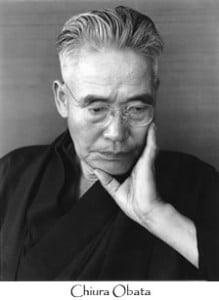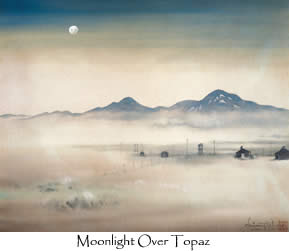Dust Storm
Art and Survival in a Time of Paranoia

Dust Storm tells a story of the internment of Japanese Americans during the second world war, using the art of Chiura Obata.
The Japanese American artist, Chiura Obata (1885-1975) was an internationally known Professor of Art at the University of California when the US was drawn into World War II. He was interned with his family and sent to Topaz relocation camp in Utah. Throughout his internment he was ceaselessly active both in documenting the experience in a series of paintings and drawings, and in striving to humanize the internment for others by setting up art schools within the camps.
Nevertheless, Obata had enemies. There were rumors that he was connected with the FBI. On the night of April 4, 1943, he had taken a shower in a communal bath house and was returning to his barracks. He was assaulted and struck with a blunt metal instrument over his left eye. He was able to tell his wife what had happened and to walk to the camp hospital where he received ten stitches. After three weeks in the camp hospital he was taken to Salt Lake City for further tests and treatment. In June he and his family were resettled in St. Louis.
It was never discovered who carried out the assault.
Synopsis

The narrator is Seiji, a Japanese American teenager at the time of internment. Seiji’s family has been devastated by the depression. They live in “the bad part of the Japanese part of Berkeley.” His father has lost his business and drinks too much. He resents the successful Obatas.
While Seiji recounts his own internment experiences, the audience sees many of the events as illustrated in Obata’s internment art.
After some months in the camps, Seiji hears that young people can apply to colleges outside of California. He pulls himself out of his depression, applies himself at school and makes out an application to the University of Arkansas. But Seiji is a Kibei, that is, he was sent to Japan for schooling for a few years. So he is suspected by the FBI. His FBI interview goes badly and he is denied permission to leave the camps.
In his bitterness he becomes prey to a radical group of pro-Japanese young people. He is recruited to spy on Obata and help set him up for the assault. Only after the crime is committed, when he visits Obata in the camp hospital, does he understand how baseless his suspicions were and that they are all living in a dust storm of lies and paranoia.
Review
by Gary Linehan , Sonora Union Democrat, 9/19/02
‘Dust Storm’ a powerful force
An unpleasant time in American history makes for engrossing viewing in “Dust Storm,” a new one-man drama by Sonora playwright Rick Foster.
Focusing on the internment of West Coast Japanese-Americans during World War II, the play was staged for students over the past week and gets three public performances this weekend at Columbia College.
In “Dust Storm” Foster places a fictional young man in an authentic setting peopled with historically correct, if physically unseen, characters. Among them is Chiura Obata, a prominent Japanese-American artist and professor at the University of California, Berkeley.
The young man, played with mesmerizing skill by Zachary Drake, begins as a rebellious Japanese-American high school student whose life is changed, along with everyone else’s, by the bombing of Pearl Harbor.
He is aware of, but not impressed by, Obata’s stature in the community and later even suspects him of being a spy for the FBI.
Within the course of an hour, the youth comes to understand more about himself and Obata through a series of events that include detainment and confinement in a series of internment camps.
The title of the play comes from a common occurrence at the barren Topaz relocation camp in Utah. It is also a frequent theme of the artwork created by Obata in the camps.
Foster’s play is generously illustrated with slides of Obata’s work from the period. Three pieces are dated Sept. 22, 1942, exactly 60 years ago this Sunday.
Like the dry tempests of the desert, “Dust Storm” is ephemeral, available for consideration only three times this weekend before moving on to an uncharted future.
It may be the most palatable examination possible of a grievous episode in history. And it’s the greatest kind of drama — the truth.
Availability and Pricing
Please contact Duende regarding production or performance rights for this play.
